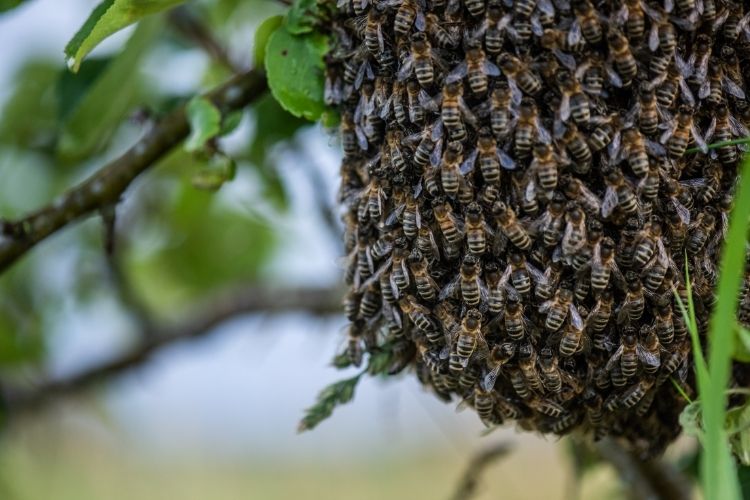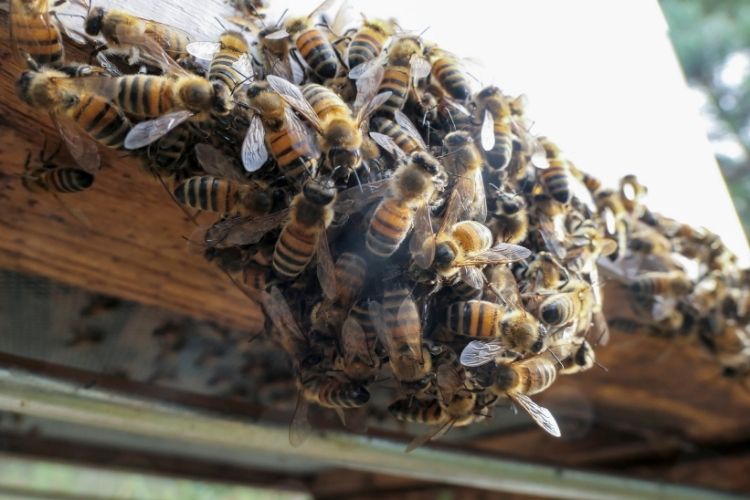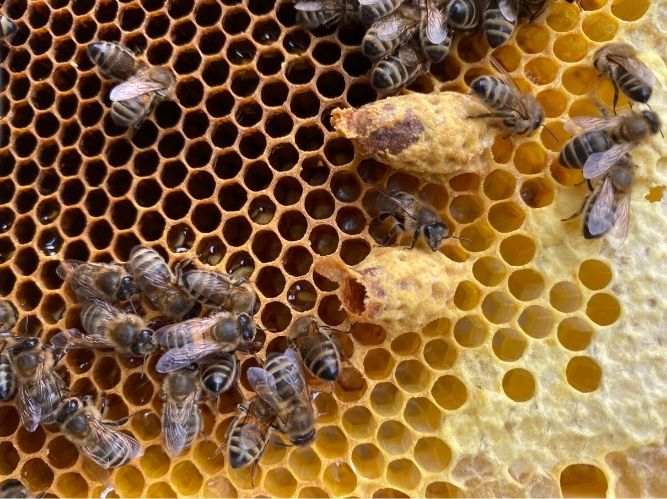Bearding and swarming are two different phenomena that occur in the lifecycle of honeybees. In both cases, a large number of bees cluster together – which is why many people mistake bees bearding for bees that are about to swarm. While there are some similarities between the two, you should be able to tell the difference by looking a bit closer.
What Is Swarming?
Swarming is when the queen and a large group of worker bees leave their hive. It can happen for two reasons.

The first reason is when the bees abscond or abandon their hive in order to survive. It could be because there is insufficient food or water, problems with disease, frequent disturbances by predators, or issues with the queen that threatens the survival. In this instance, the entire colony leaves the hive.
The second reason bees might swarm is as a natural means of reproduction that occurs when a colony of bees run out of space in their existing hive. Rather than the entire colony leaving, it splits into two separate colonies.
The queen and a large number of workers leave the hive to create a new one. Before swarming, bees will deprive the queen of food so that she loses enough weight to fly. They will then create a number of queen cells so that a new queen can take over the hive.
Scout bees will fly to find a new location for the hive to cluster temporarily (usually for a few hours), before sending more scouts to find a suitable place to create the new hive.
What Is Bearding?
Bearding is when, rather than go inside the hive, bees hang outside the entrance in large clusters. Because of the shape, it often gives the appearance that the hive has grown a beard of bees.

Bees beard to control the internal temperature and humidity levels of the hive. You see, when the hive becomes too hot, the brood begins to die, threatening the existence of the colony.
On top of that, the high level of humidity means bees are not able to reduce the moisture content of nectar and turn it into honey, which could leave the colony without enough food to survive.
That’s why bees beard outside the hive – so they can create more space inside the hive which allows for more ventilation. Sometimes you might even see them sitting at the entrance of the hive fanning their wings to help with air flow.
Bearding is a completely natural behaviour and the sign of a healthy hive. Swarming, on the other hand, indicates there may be something wrong. That’s why, if you’re not sure whether your bees are bearding or preparing to swarm, it’s a good idea to check.
The Differences Between Swarming And Bearding
Bearding bees might look like they’re preparing to swarm at first sight, but there are a few differences you can use to be sure of which one is happening.
Time Of Year
The first clue as to whether your bees are swarming or bearding is the time of the year.
Swarming typically occurs during mid-late Spring, because many flowers are in bloom. This allows bees to collect a lot of pollen and nectar, providing optimal conditions for the queen to lay more eggs and the colony to grow in size. When the colony becomes too large for their hive, some of the bees will start preparing to swarm.
Bearding usually occurs during Summer or when the weather is very hot. A hot and humid climate can make it more difficult for bees to regulate the internal temperature of their hive, forcing them to hang outside as they wait for it to cool down.
Time Of Day
As well as the time of year, the time of day also usually differs between bearding and swarming.
Bees tend to swarm in the middle part of the day, between 10am and 2pm. This gives them enough time to cluster and scout a new location for their hive.
Bearding, on the other hand, typically occurs in the late afternoon or at night. That’s because bees are out of the hive during the day collecting pollen and nectar. When they return to find the hive is too hot, they cluster outside.
The Level Of Activity
Bees preparing to swarm are typically very loud and active. You will likely see large numbers of bees moving rapidly and some flying around.
When bees are bearding, they will be very docile and rarely take flight. Instead, they tend to cluster together in a large group on the landing board or around the outside of the hive. You might see some of the bees fanning their wings into the hive trying to increase ventilation.
Amount Of Space Inside The Hive
Bees swarm when they have run out of space inside the hive to continue building more comb – which is essential to store food and raise more brood. When this happens, the colony has grown too large for the hive, and will decide to split it in two.
If you suspect your bees are preparing to swarm, check the hive to see how much space is left on each of the frames. If the bees have built comb all the way to the edges of the frame and have nowhere left to build – especially if the comb is full of food or brood – they could very well be preparing to swarm.
If this is the case, you will likely notice an abundance of idle worker bees who have nothing to do – because there is barely any room to store more food or raise more brood.
Sometimes a lack of space can also make it difficult to regulate the internal temperature of the hive, which could force bees to beard outside. So not enough room does not necessarily mean the hive is going to swarm just yet – but it’s likely they will at some point in the near future.
Either way, if you notice a lack of space, it’s time to either add more frames or another brood box or honey super, or split the hive.
The Presence Of Queen Cells
The presence of queen cells is a big giveaway your hive is preparing to swarm.
If bees are preparing to swarm and split the colony in two, they must raise a new queen to leave behind. To do this, they build queen cell cups, into which the current queen will lay eggs. These are long, vertical beeswax cells that can usually be found on the bottom or outer edges of the comb.

If you suspect your colony is preparing to swarm, then inspect your hive and search for queen cells. If you find some – especially ones that contain eggs or larvae – it is highly likely your hive is preparing to swarm. If you find capped cells, the swarm is imminent.
It takes around 9 days after capping for the new queen to emerge. So, if there are capped queen cells, it means the hive will swarm sometime within the next 9 days.
If the queen cells are capped, the swarm could happen any day.
If your bees are bearding, on the other hand, they have no reason to raise another queen – so there should be no queen cells.
Swarming Vs Bearding: How To Tell The Difference
| Swarming | Bearding |
| Swarming typically occurs in mid-late Spring or early Summer, when flowers are in bloom, as this creates optimal conditions for the colony’s population to grow rapidly. | Bearding typically occurs during Summer when the weather is hot and humid, making it more difficult to regulate the internal temperature of the hive. |
| Swarming will most likely occur during the middle of the day, between the hours of 10 am-2 pm, giving the bees enough time to cluster, before scouting for a new home. | Bearding will most likely occur in the late afternoon or evening when bees return home after collecting pollen and nectar only to find their hive is too hot inside. |
| Bees that are about to swarm are typically loud and active (especially aerially). | Bees that are bearding tend to stay grounded and huddle in large clusters on the landing board or outside of the hive. |
| Before a colony swarms, they need to raise a new queen to take over the hive – so you’ll find queen cells (vertical, peanut-shaped beeswax cells) on the outer edges of the comb. | If your bees are bearding, you may notice some fanning their wings towards the entrance in an attempt to improve ventilation and cool down the hive. |
| Bees swarming is the sign of a strong colony that has outgrown its hive, so you’ll notice there is little or no room to build additional comb on any of the frames. | A lack of space can contribute to bees bearding – but it’s also something you need to resolve as soon as possible, because it means they will likely prepare to swarm sometime soon unless additional space is provided. |
Summing Up…
Bearding is when bees hang outside the hive, typically in the late afternoon or at night. They do this to reduce the number of bees inside and help cool down their hive.
Swarming typically happens as a natural means of reproduction and occurs when the colony has outgrown the hive. Around half the hive, along with the queen, will leave to find a new home.
If your bees are preparing to swarm, you will need to split the hive or provide additional frames upon which they can continue to build comb – which is necessary to store food and brood.
